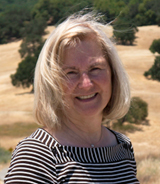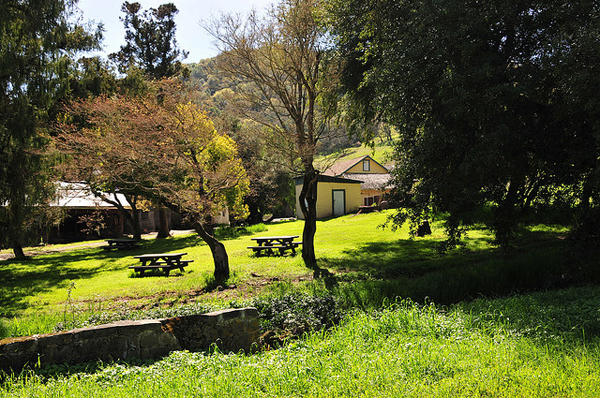Olompali State Historic Park, located just west of Highway 101 between Novato and Petaluma, is rich in both natural and human history. But despite its location right next to a major highway, it is less well-known and less visited than some of its other North Bay cousins in the state park system. Here visitors can enjoy healthy oak woodlands, panoramic vistas from the summit of Mount Burdell, and artifacts from layer upon layer of California history. Diane Einstein, long-time Marin County resident, is the chairperson of The Olompali People, the nonprofit support organization for the park. She shared her stories and wisdom with me last week.

BN: “The Olompali People” sounds like a Native American group. Is that so?
Einstein: The Olompali (pronounced O-lom- PA-li)People is like a “Friends Of…” organization;. we do volunteer work and fundraising on behalf of Olompali Park. But why the name? Well, look at the acronyms: TOP versus FOO. We called ourselves The Olompali People instead of Friends of Olompali because it looks and sounds much better.
BN: Are you originally from the Bay Area?
Einstein: Yes, I grew up in Fairfax. As a child, I was on MMWD [Marin Municipal Water District] land all the time, exploring the trails around Bon Tempe and Phoenix Lakes. To me being in the outdoors is just second nature.
I got involved in Olompali in 1982 when I was living in Novato after moving there back in 1974. I was training with Elizabeth Terwilliger, the legendary naturalist and pioneering outdoor educator, to be a guide at her Nature Education Center. She was looking for a north Marin site as an “outdoor classroom” for school groups in North Marin and Sonoma. We viewed several locations. When I first visited Olompali, I didn’t know anything about it. I was astounded at the rich ecology there. It had riparian areas, grasslands, oak woodlands, and diverse forests. It was the perfect setting for nature hikes.
And then, the history! The cultural history was so compelling! I didn’t know that Olompali had been a major trading village; or that during an archaeological dig in the 1970’s, scientists had found a sixpence coin, confirming through carbon dating that Drake had landed in Marin in the late 1500s.
You can pick any point in time, and Olompali has amazing stories to tell. In fact, you could teach the entire history of California using only Olompali to illustrate the different periods.
BN: What is your favorite story?
Einstein: My favorite stories are about the mixing and mingling of six different cultural narratives: Native American, Spanish, Mexican, Pioneer, Victorian and Contemporary American.
One of my favorite historical figures is Camilo Ynitia, a Coast Miwok who started out at Olompali caring for the livestock that belonged to Mission San Rafael. The missionaries kept them there because there was plentiful water, and because it was a good rest spot, about half way between Mission San Rafael and Mission Sonoma.
When the missions were secularized, Vallejo supported Ynitia in getting an 8,800-acre land grant. Ynitia was a highly respected individual, and the only Native American in California to get a large land grant. He maintained his status when California passed from Mexico to the United States. But then the United States Land Commission challenged all the historical land grants, so he began a court case to validate his claim.
Ynitia had seen how the Spanish, the Mexicans, and now the United States government treated Native Americans. For this reason, I believe, he decided to sell the majority of his land to a white friend, James Black, who would presumably have a better chance in court. Black pursued the case in federal court and after five years he prevailed. I’m always amazed by Ynitia’s courage and adaptability. He persevered and thrived through four different cultures. That’s Camilo!
BN: What are some of the accomplishments of The Olompali People?
Einstein: We work in conjunction with the Marin State Parks Association at Olompali, We have established an information center and a sales area at the park. And we just put on our 28th annual Heritage Day, a popular event. It’s a day on which all kinds of organizations come and do interactive educational demonstrations at the park. For example, this year we had WildCare, which grew out of Terwilliger’s organization; and the California Coastal Commission, which shared information about the salt marshes. Also, There is a state plan for the park, and we have worked with the Marin State Parks Association to help ensure its implementation. For example, we obtained a grant from the California Cultural Endowment to rehabilitate the Burdell Garden, and we obtained the necessary planning and construction documents. Mary Burdell was James Black’s daughter, to whom Black gave the land when she got married.
BN: What are some of the challenges you face?
Einstein: With the recent crisis in the State Parks system, we’ve had to struggle to keep the park open. We don’t have a ranger, just a maintenance person and park hosts. We’re only open five days a week now. So we’re appealing for volunteers to staff the visitor center, and to come out for work days. so we can stay open.
BN: What’s your favorite outdoor destination in the Bay Area?
Einstein: I really love the vistas from Mount Tam and from the top of the loop trail at Olompali. At Olompali you can see all of the marshland and the Petaluma river basin as it reaches San Pablo Bay. On a clear day, you can even see Mount Diablo.
>> Learn more about the Olompali People or about the history of Olompali State Park. Then take a hike there using Bay Nature’s Trailfinder as your guide!





